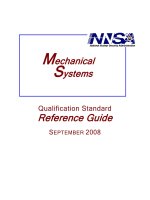Verilog Reference guide pdf
Bạn đang xem bản rút gọn của tài liệu. Xem và tải ngay bản đầy đủ của tài liệu tại đây (270.43 KB, 151 trang )
The
Verilog
®
Golden
Reference
Guide
DOULOS
DOULOS
Church Hatch,
22 Market Place,
Ringwood.
Hampshire.
BH24 1AW
England.
Tel (+44) (0)1425 471223
Fax (+44) (0)1425 471573
Email
URL
© Copyright 1996, Doulos, All Rights Reserved.
No part of this publication may be reproduced, stored in a retrieval
system, or transmitted, in any form or by any means, electronic,
mechanical, photocopying, recording or otherwise, without the
prior written permission of DOULOS. Printed in the United
Kingdom of Great Britain and Northern Ireland.
Version 1.0, August 1996
Verilog-XL
TM
is a trademark and Verilog
®
a registered trademark of
Cadence Design Systems Inc.
The Verilog Golden Reference Guide is a compact quick reference
guide to the Verilog hardware description language, its syntax,
semantics, synthesis and application to hardware design.
The Verilog Golden Reference Guide is not intended as a
replacement for the IEEE Standard Verilog Language Reference
Manual. Unlike that document, the Golden Reference guide does not
offer a complete, formal description of Verilog. Rather, it offers
answers to the questions most often asked during the practical
application of Verilog, in a convenient reference format.
Nor is The Verilog Golden Reference Guide intended to be an
introductory tutorial. Information is presented here in a terse
reference format, not in the progressive and sympathetic manner
necessary to learn a subject as complex as Verilog. However,
acknowledging that those already familiar with computer languages
may wish to use this guide as a Verilog text book, a brief informal
introduction to the subject is given at the start.
The main feature of The Verilog Golden Reference Guide is that it
embodies much practical wisdom gathered over many Verilog
projects. It does not only provide a handy syntax reference; there are
many similar books which perform that task adequately. It also
warns you of the most common language errors, gives clues where
to look when your code will not compile, alerts you to synthesis
issues, and gives advice on improving your coding style.
The Verilog Golden Reference Guide was developed to add value to
the Doulos range of Verilog training courses, and also to complement
HDL PaceMaker, the Verilog Computer Based Training package
from Doulos.
3
Preface
The main body of this guide is divided into three main parts, each of
which is organised alphabetically. Each section is indexed by a key
term which appears prominently at the top of each page. Often you
can find the information you want by flicking through the guide
looking for the appropriate key term. If that fails, there is a full index
at the back.
Most of the information in this guide is organised around the Verilog
syntax headings, but there are additional special sections on Coding
Standards, Design Flow, Errors, Reserved Words and, after the main
alphabetical reference section, Compiler Directives, System Tasks
and Functions and Command Line Options.
If you are new to Verilog, you should start by reading A Brief
Introduction to Verilog, which follows overleaf.
The Index
Bold index entries have corresponding pages in the main body of the
guide. The remaining index entries are followed by a list of
appropriate page references in the alphabetical reference sections,
given in order of importance.
Key To Notation Used To Define Verilog Syntax
The syntax definitions are written to look like examples wherever
possible, but it has been necessary to introduce some extra notation.
In brief, square brackets [] enclose optional items, three dots means
repetition, and curly brackets {} enclose comments. ItalicNames
represent parts of the syntax defined elsewhere. A full description of
the notation follows:
Curly brackets {} enclose comments that are not part of the Verilog
syntax being defined, but give you further information about the
syntax definition. Bold curly brackets {} are part of the Verilog syntax
(concatenation operator).
Syntax enclosed in square brackets [] is optional. Bold square
brackets [] are part of the Verilog syntax (vector range, bit and part
select, memory element).
means zero or more repetitions of the preceding item or line, or
means a list, as follows:
Item means zero or more repetitions of the Item.
, means repeat in a comma separated list (e.g. A, B, C).
4
Using This Guide
There must be at least one item in the list. There is no , at the end of
the list.
Words in lower-case letters are reserved words, built into the Verilog
language (e.g. module)
Capitalised Words (not in italics) are Verilog identifiers, i.e. user
defined names that are not reserved identifiers (e.g. InstanceName).
Italic Words are syntactic categories, i.e. the name of a syntax
definition given in full elsewhere. A syntactic category can be either
defined on the same page, defined on a separate page, or one of the
special categories defined below.
Italics = indicates a syntactic category which is defined and used on
the same page.
Special syntactic categories:
MinTypMaxExpression is defined with Expression.
UnsignedNumber is defined with Number.
SomethingExpression = Expression, where the Something gives
information about the meaning of the expression (e.g.
ConstantExpression, ConstantMinTypMaxExpression).
5
The following paragraphs give a brief technical introduction to
Verilog suitable for the reader with no prior knowledge of the
language.
Background
The Verilog Hardware Description Language (HDL) is a language for
describing the behaviour and structure of electronic circuits, and is
an IEEE standard (IEEE Std. 1364-1995).
Verilog is used to simulate the functionality of digital electronic
circuits at levels of abstraction ranging from stochastic and pure
behaviour down to gate and switch level, and is also used to
synthesize (i.e. automatically generate) gate level descriptions from
more abstract (Register Transfer Level) descriptions. Verilog is
commonly used to support the high level design (or language based
design) process, in which an electronic design is verified by means of
thorough simulation at a high level of abstraction before proceeding
to detailed design using automatic synthesis tools. Verilog is also
widely used for gate level verification of ICs, including simulation,
fault simulation and timing verification.
The Verilog HDL was originally developed together with the
Verilog-XL simulator by Gateway Design Automation, and
introduced in 1984. In 1989 Cadence Design Systems acquired
Gateway, and with it the rights to the Verilog language and the
Verilog-XL simulator. In 1990 Cadence placed the Verilog language
(but not Verilog-XL) into the public domain. A non profit making
organisation, Open Verilog International (OVI) was formed with the
task of taking the language through the IEEE standardization
procedure, and Verilog became an IEEE standard in 1995. OVI will
continue to maintain and develop the language.
The Language
In this section as in the rest of the guide, words given in Capitalised
Italics are technical terms whose definitions may be found in the
main body of this guide.
An hierarchical portion of a hardware design is described in Verilog
by a Module. The Module defines both the interface to the block of
hardware (i.e. the inputs and outputs) and its internal structure or
behaviour.
A number of primitives, or Gates, are built into the Verilog language.
They represent basic logic gates (e.g. and, or). In addition User
Defined Primitives (UDPs) may be defined.
6
A Brief Introduction To Verilog
The structure of an electronic circuit is described by making Instances
of Modules and Primitives (UDPs and Gates) within a higher level
Module, and connecting the Instances together using Nets. A Net
represents an electrical connection, a wire or a bus. A list of Port
connections is used to connect Nets to the Ports of a Module or
Primitive Instance, where a Port represents a pin. Registers (see below)
may also be connected to the input Ports (only) of an Instance.
Nets (and Registers) have values formed from the logic values 0, 1, X
(unknown or uninitialised) and Z (high impedance or floating). In
addition to logic values, Nets also have a Strength value. Strengths are
used extensively in switch level models, and to resolve situations
where a net has more than one driver.
The behaviour of an electronic circuit is described using Initial and
Always constructs and Continuous Assignments. Along with UDPs and
Gates these represent the leaves in the hierarchy tree of the design.
Each Initial, Always, Continuous Assignment, UDP and Gate Instance
executes concurrently with respect to all others, but the Statements
inside an Initial or Always are in many ways similar to the statements
in a software programming language. They are executed at times
dictated by Timing Controls, such as delays, and (simulation) event
controls. Statements execute in sequence in a Begin-End block, or in
parallel in a Fork-Join block. A Continuous Assignment modifies the
values of Nets. An Initial or Always modifies the values of Registers.
An Initial or Always can be decomposed into named Tasks and
Functions, which can be given arguments. There are also a number of
built in System Tasks and Functions. The Programming Language
Interface (PLI) is an integral part of the Verilog language, and
provides a means of calling functions written in C in the same way as
System Tasks and Functions.
Compilation
Verilog source code is usually typed into one or more text files on a
computer. Those text files are then submitted to a Verilog compiler
or interpreter which builds the data files necessary for simulation or
synthesis. Sometimes simulation immediately follows compilation
with no intermediate data files being created.
7
Module Structure
module M (P1, P2, P3, P4);
input P1, P2;
output [7:0] P3;
inout P4;
reg [7:0] R1, M1[1:1024];
wire W1, W2, W3, W4;
parameter C1 = "This is a string";
initial
begin : BlockName
// Statements
end
always
begin
// Statements
end
// Continuous assignments
assign W1 = Expression;
wire (Strong1, Weak0) [3:0] #(2,3) W2 = Expression;
// Module instances
COMP U1 (W3, W4);
COMP U2 (.P1(W3), .P2(W4));
task T1;
input A1;
inout A2;
output A3;
begin
// Statements
end
endtask
function [7:0] F1;
input A1;
begin
// Statements
F1 = Expression;
end
endfunction
endmodule
8
Syntax Summary
Statements
#delay
wait (Expression)
@(A or B or C)
@(posedge Clk)
Reg = Expression;
Reg <= Expression;
VectorReg[Bit] = Expression;
VectorReg[MSB:LSB] = Expression;
Memory[Address] = Expression;
assign Reg = Expression
deassign Reg;
TaskEnable( );
disable TaskOrBlock;
-> EventName;
if (Condition)
else if (Condition)
else
case (Selection)
Choice1 :
Choice2, Choice3 :
default :
endcase
for (I=0; I<MAX; I=I+1)
repeat (8)
while (Condition)
forever
This quick reference syntax summary does not follow the notational conventions
used in the rest of the Guide.
9
10
The
Verilog
Golden
Reference
Guide
Alphabetical Reference Section
11
Contains one or more statements (procedural assignments, task enables, if,
case and loop statements), which are executed repeatedly throughout a
simulation run, as directed by their timing controls.
Syntax
always
Statement
Where
module-<HERE>-endmodule
Rules
Only registers (reg, integer, real, time, realtime) may be assigned in an
always.
Every always starts executing at the start of simulation, and continues
executing throughout simulation; when the last statement in the always is
reached, execution continues from the top of the always.
Gotchas!
An always containing more than one statement must enclose the statements
in a begin-end or fork-join block.
An always with no timing controls will loop forever.
Synthesis
always is one of the most useful Verilog statements for synthesis, yet an
always is often unsynthesizable. For best results, code should be restricted
to one of the following templates:
always @(Inputs) // All the inputs
begin
// Combinational logic
end
always @(Inputs) // All the inputs
if (Enable)
begin
// Latched actions
end
12
Always
always @(posedge Clock) // Clock only
begin
// Synchronous actions
end
always @(posedge Clock or negedge Reset)
// Clock and Reset only
begin
if (!Reset) // Test active level of asynchronous reset
// Asynchronous actions
else
// Synchronous actions
end // Gives flipflops + logic
Example
The following example shows a Register Transfer Level always:
always @(posedge Clock or negedge Reset)
begin
if (!Reset) // Asynchronous reset
Count <= 0;
else
if (!Load) // Synchronous load
Count <= Data;
else
Count <= Count + 1;
end
The following example shows an always which describes combinational logic:
always @(A or B or C or D)
begin
R = {A, B, C, D}
F = 0;
begin : Loop
integer I;
for (I = 0; I < 4; I = I + 1)
if (R[I])
begin
F = I;
disable Loop;
end
end // Loop
end
See Also
Begin, Fork, Initial, Statement, Timing Control
13
Used to group statements, so that they execute in sequence. The Verilog
syntax often requires exactly one statement, for example in an always. If
more than one statement is needed, the statements may be included in a
begin-end block.
Syntax
begin [:
Label
[
Declarations
]]
Statements
end
Declaration =
{either}
Register Parameter Event
Where
See Statement.
Rules
A begin-end block must contain at least one statement.
Statements in a begin-end block are executed in sequence. Timing controls
are relative to the previous statement. The begin-end block completes when
the bottom-most statement has completed.
Begin-end and fork-join blocks may be nested within themselves and each
other.
If a begin-end block is to contain local declarations, it must be named (i.e. it
must have a label).
If a begin-end block is to be disabled, it must be named.
Gotchas!
The Verilog LRM allows begin-end blocks to be interleaved during simulation.
This means that even where a begin-end block contains two adjacent
statements with no timing control between them, a simulator may choose to
execute part of another process (E.g. statements in another always) between
the two statements. This is a source of non-determinism in the language.
Tips
Begin-end blocks can be labelled to improve readability, even if there are no
local declarations, and the block is not to be disabled.
Use local declarations for registers that will not be used elsewhere. This
makes the intent of the declaration explicit.
14
Begin
Example
initial
begin : GenerateInputs
integer I;
for (I = 0; I < 8; I = I + 1)
#Period {A, B, C} = I;
end
initial
begin
Load = 0; // Time 0
Enable = 0;
Reset = 0;
#10 Reset = 1; // Time 10
#25 Enable = 1; // Time 35
#100 Load = 1; // Time 135
end
See Also
Fork, Disable, Statement.
15
A statement which conditionally executes at most one branch, depending on
the value of the case expression.
Syntax
CaseKeyword
(
Expression
)
Expression,
:
Statement
{Expression may be variable}
Expression,
:
Statement
{Any number of cases}
[default [:]
Statement
] {Need not be at the end}
endcase
CaseKeyword =
{either} case casex casez
Where
See Statement.
Rules
Xs and Zs in a casex statement, and Zs in a casez statement mean “don’t
care”.
One default statement at most may be included. It is executed if no label
expressions match the case expression. (A ‘label’ is an expression or a
comma-separated list of expressions on the left of a colon, or the reserved
word default, which may or may not be followed by a colon.)
Where a label is a comma-separated list of two or more expressions, the label
is matched if the case expression matches any one of the label expressions.
If no label expressions match the case expression and there is no default
statement, the case statement has no effect.
Gotchas!
If more than one statement is to be executed for a particular label, the
statements must be enclosed in a begin-end or fork-join block.
A branch is only executed if the corresponding label is the first one to match
the case expression. Case labels need not be mutually exclusive, so a
Verilog compiler will not report an error where the same label has erroneously
been repeated.
The syntax of a casex or casez statement ends with the reserved word
endcase, not endcasex or endcasez.
An X or Z in the casex expression or a Z in a casez expression is matched
with any value in a case label. This may give confusing simulation results.
Synthesis
Assignments within case statements generally synthesize to multiplexers. If
variables (i.e. registers or nets) are used for case labels, priority encoders
may be synthesized.
16
Case
Incomplete assignments (i.e. where outputs remain unassigned for certain
input conditions) in an unclocked always synthesize to transparent latches.
Incomplete assignments in a clocked always synthesize to recirculation
around registers.
Tips
For simulation, always use default as the last case statement, to trap illegal
conditions.
casez is usually preferable to casex, because the presence of Xs in
simulation may give misleading or confusing results.
Use the alternative character ? for Z in casex and casez labels. This makes it
clear that a “don’t care” value and not a high impedance value is intended.
Example
case (Address)
0 : A <= 1; // Select a single Address value
1 : begin // Execute more than one statement
A <= 1;
B <= 1;
end
2, 3, 4 : C <= 1; // Pick out several Address values
default : // Mop up the rest
$display("Illegal Address value %h in %m at %t",
Address, $realtime);
endcase
casex (Instruction)
8'b000xxxxx : Valid <= 1;
8'b1xxxxxxx : Neg <= 1;
default
begin
Valid <= 0;
Neg <= 0;
end
endcase
casez ({A, B, C, D, E[3:0]})
8'b1??????? : Op <= 2'b00;
8'b010????? : Op <= 2'b01;
8'b001???00 : Op <= 2'b10;
default : Op <= 2'bxx;
endcase
See Also
If
17
Coding standards are divided into two categories. Lexical coding standards,
which control text layout, naming conventions and commenting, are intended
to improve readability and ease of maintenance. Synthesis coding standards,
which control Verilog style, are intended to avoid common synthesis pitfalls
and find synthesis errors early in the design flow.
The following lists of coding standards will need to be modified according to
the choice of tools and personal preferences.
Lexical Coding Standards
Limit the contents of each Verilog source file to one module, and do not split
modules across files.
Source file names should relate to the file contents (e.g. ModuleName.v).
Write only one declaration or statement per line.
Use indentation as shown in the examples.
Be consistent about the case of user defined names (e.g. first letter a capital).
User defined names should be meaningful and informative, although local
names (e.g. loop variables) may be terse.
Write comments to explain (not duplicate) the Verilog code. It is particularly
important to comment interfaces (e.g. module parameters, ports, task and
function arguments).
Use parameters or `define macros wherever possible, instead of directly
embedding literal numbers and strings in declarations and statements.
Synthesis Coding Standards
Partition the design into small functional blocks, and use a behavioural style
for each block. Avoid gate level descriptions except for critical parts of the
design.
Have a well defined clocking strategy, and implement that strategy explicitly in
Verilog (e.g. single clock, multi-phase clocks, gated clocks, multiple clock
domains). Ensure that clock and reset signals in Verilog are clean (i.e. not
generated from combinational logic or unintentionally gated).
Have a well defined (manufacturing) testing strategy, and code up the Verilog
appropriately (e.g. all flipflops resettable, test access from external pins, no
functional redundancy).
Every Verilog always should conform to one of the standard synthesizable
process templates (see
Always
).
An always describing combinational and latched logic must have all of the
inputs in the event control list at the top of the always.
A combinational always must not contain incomplete assignments, i.e. all
outputs must be assigned for all combinations of input values.
An always describing combinational and latched logic must not contain
feedback, i.e. registers assigned as outputs from the always must not be
read as inputs to the always.
18
Coding Standards
A clocked always must have only the clock and any asynchronous control
inputs (usually reset or set) in the event control list.
Avoid unwanted latches. Unwanted latches are caused by incomplete
assignments in an unclocked always.
Avoid unwanted flipflops. Flipflops are synthesized when registers are
assigned in a clocked always using a non-blocking assignment, or when
registers retain their value between successive iterations of a clocked always
and thus between clock cycles).
All internal state registers must be resettable, in order that the Register
Transfer Level and gate level descriptions can be reset into the same known
state for verification. (This does not apply to pipeline or synchronization
registers.)
For finite state machines and other sequential circuits with unreachable states
(e.g. a 4 bit decade counter has 6 unreachable states), if the behaviour of the
hardware in such states is to be controlled, then the behaviour in all 2
N
possible states must be described explicitly in Verilog, including the behaviour
in unreachable states. This allows safe state machines to be synthesized.
Avoid delays in assignments, except where necessary to solve the problem of
zero delay clock skew at Register Transfer Level.
Do not use registers of type integer or time, otherwise they will synthesize to
32 bit busses and 64 bit busses respectively.
Check carefully any Verilog code which uses dynamic indexing (i.e. a bit
select or memory element using a variable index or address), loop
statements, or arithmetic operators, because such code can synthesize to
large numbers of gates which can be hard to optimize.
19
Comments may be (should be!) included to document the Verilog source
code.
Syntax
{single line comment}
//
{multi-line comment}
/* */
Where
Nearly anywhere, but not so as to split operators, numbers, strings, names
and keywords.
Rules
A single line comment starts with the two slash characters and ends at the
end of the line.
A multi-line comment starts with /* and continues, possibly across multiple
lines, until the next */
Multi-line comments may not be nested. However, there may be single line
comments inside a multi-line comment, where they have no special meaning.
Gotchas!
/* /* */ */ - the comment ends at the first */, and the second /* is
ignored. This would almost certainly give syntax errors.
Tips
Use single line comments throughout. Only use multi-line comments where it
is necessary to comment out a large section of code, for example during
development and debugging of the code.
Example
// This is a comment
/*
So is this - across three lines
*/
module ALU /* 8-bit ALU */ (A, B, Opcode, F);
See Also
Coding Standards
20
Comment
A continuous assignment creates events on one or more nets whenever a net
or register in an expression changes value.
Syntax
{either}
assign [
Strength
] [
Delay
]
NetLValue = Expression,
NetLValue = Expression,
;
NetType
[
Expansion
]
[
Strength
]
[
Range
] [
Delay
]
NetName =
Expression,
NetName =
Expression,
; {See Net}
NetLValue
= {either}
NetName
NetName[
ConstantExpression
]
NetName[
ConstantExpression
:
ConstantExpression
]
{
NetLValue
, }
Where
module-<HERE>-endmodule
Rules
The two forms of continuous assignment have the same effect.
The nets on the left hand side of an assign must have been declared
explicitly in the source code before the continuous assignment statement.
Gotchas!
Continuous assignments are not the same as procedural continuous
assignments, although they are similar. Make sure that you place assign in
the correct place. A continuous assignment goes outside any initial or
always. A procedural continuous assignment goes where statements are
allowed (inside initial, always, task, function etc.).
Synthesis
Delays and strengths are ignored by synthesis tools; use tool specific timing
constraints instead.
Continuous assignments are synthesized as combinational logic.
Tips
Use continuous assignments to describe combinational logic that can easily
be described using a straightforward expression. Functions can be used to
structure expressions. An always is usually better for describing more
complex combinational logic, and may simulate more quickly than a number
of separate continuous assignment statements.
21
Continuous Assignment
Continuous assignments are useful for transferring register values to nets,
when Verilog requires nets to be used. For example, to apply test stimulus
described in an initial to an inout port of a module instance.
Example
wire cout, cin;
wire [31:0] sum, a, b;
assign {cout, sum} = a + b + cin;
wire enable;
reg [7:0] data;
wire [7:0] #(3,4) f = enable ? data : 8'bz;
See Also
Net, Force, Procedural Continuous Assignment
22
Overrides parameter values at compile time. Using hierarchical names,
parameter values can be overridden from anywhere inside or outside a
design’s hierarchy.
Syntax
defparam ParameterName =
ConstantExpression,
ParameterName =
ConstantExpression,
;
Where
module-<HERE>-endmodule
Synthesis
Not generally synthesizable.
Tips
Do not use defparam! It used to provide a useful way of back-annotating
layout delays, but this is now normally done using specify blocks and the
Programming Language Interface. To override the values of parameters, use
the # syntax in a module instantiation.
Example
`timescale 1ns / 1ps
module LayoutDelays;
defparam Design.U1.T_f = 2.7;
defparam Design.U2.T_f = 3.1;
endmodule
module Design ( );
and_gate U1 (f, a, b);
and_gate U2 (f, a, b);
endmodule
module and_gate (f, a, b);
output f;
input a, b;
parameter T_f = 2;
and #(T_f) (f,a,b);
endmodule
See Also
Name, Instantiation, Parameter
23
Defparam
Delays may be specified for instances of UDPs and gates, for continuous
assignments, and for nets. These delays model the propagation delay of
components and connections in a netlist.
Syntax
{either}
#
DelayValue
#(
DelayValue
[,
DelayValue
[,
DelayValue
]]) {Rise,Fall,Turn-Off}
DelayValue
= {either}
UnsignedNumber
ParameterName
ConstantMinTypMaxExpression
Where
See Continuous Assignment, Instantiation, Net.
Rules
Where only one delay value is given, it represents both the rising and falling
propagation delays (i.e. transition to 1 or 0 respectively), and the turn off delay
(if applicable).
Where two delay values are given, the first is the rise delay and the second is
the fall delay, except for tranif0, tranif1, rtranif0 and rtranif1, where the first
value is the turn on delay, and the second is the turn off delay.
Where three delay values are given, the third delay is the turn off delay
(transition to Z), except for trireg nets, where the third delay is the charge
decay time.
Delay to X is the smallest of the specified delays.
For vectors, a transition from non-zero to zero is considered to be a ‘fall’, a
transition to Z is considered to be a ‘turn-off’, and any other transitions are
considered to be a ‘rise’.
Gotchas
Many tools insist that MinTypMax expressions in delays must always be
bracketed. For example #(1:2:3) is allowed, but #1:2:3 is not.
Synthesis
Delays are ignored by synthesis tools. Delays in synthesized netlists are
constrained by synthesis tool commands, such as setting the maximum clock
period.
Tips
Specify block delays (path delays) are usually a more accurate way of
modelling delays, and provide a mechanism for delay calculation and
backannotation of layout information.
24
Delay
See Also
Net, Instantiation, Continuous Assignment, Specify, Timing Control
25









